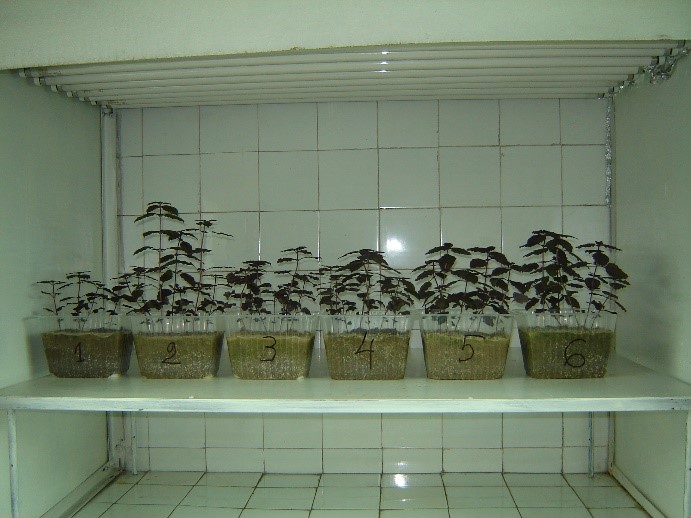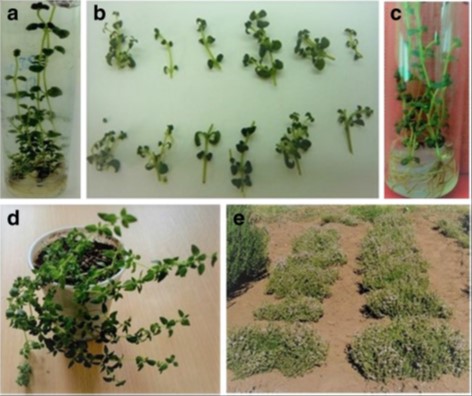“PLANT-SOIL INTERACTIONS” – Scientific Achievements – Research Group 3
Research Group
Microorganism-plant symbiotic interactions. Influence of various environmental stress factors in separate and combined inoculation with microorganisms on productivity and quality of yield in plants
- The investigation of the effect of dual inoculation on basil plant growth and to characterize the physiological basis by determination of the following indicators: mycorrhizal colonization; glomalin related soil protein; acid phosphatase activity (in root and soil); carbon-nitrogen metabolic status, enzyme and non enzyme antioxidant capacity.
- It has been studied the changes in natural antioxidants after inoculation of in vitro propagated garden thyme plants with arbuscular mycorrhizal fungi (AMF).
- Evaluation of the effectiveness of symbioses between cowpea plants (Vigna unguiculata (L.) Walp.), AM fungi (Glomus intraradices) and two strains of Bradyrhizobium japonicum on the mycorrhization, acid phosphatase activity (APase), enzymes related to nitrogen fixation and assimilation, and biomass accumulation at three soil moisture levels.
The rhizosphere microbial community is a complex of organisms interconnecting in multifold ways, acting upon each other and reacting to the surrounding environment. It was evaluated for the first time the impact of microalgae (Scenedesmus incrassatulus R83 and Synechocystis sp. R10) solely and in combination with arbuscular mycorrhizal fungi (AMF) on Ocimum basilicum L. enzyme and non enzyme antioxidant capacity, AMF function (colonization and glomalin-related soil proteins), acid phosphatase activity (in root and soil), plant growth, and the activity of plant enzymes linking nitrogen and carbon metabolism (glutamate synthase, aspartate aminotransferase and NADP-malic enzyme).
 The highest values of biometrical data were as a result of mycorrhiza application alone and in the mixed treatments with both microalgae strains. Dual inoculation with both microalgae and AMF, stimulated mycorrhizal function (concentration of glomalin-related proteins). The results for activities of nitrogen-carbon metabolizing enzymes demonstrated close relationships with the plant growth. The targeted inoculation of O. basilicum with AMF or algae (alone and in combination) enhanced the antioxidant capacity of the plants and the degree of stimulation varied depending on the treatment.
The highest values of biometrical data were as a result of mycorrhiza application alone and in the mixed treatments with both microalgae strains. Dual inoculation with both microalgae and AMF, stimulated mycorrhizal function (concentration of glomalin-related proteins). The results for activities of nitrogen-carbon metabolizing enzymes demonstrated close relationships with the plant growth. The targeted inoculation of O. basilicum with AMF or algae (alone and in combination) enhanced the antioxidant capacity of the plants and the degree of stimulation varied depending on the treatment.
 Plants in symbiosis with AMF exhibited the highest antioxidant potential as was indicated by the enhanced functions of all studied leaf AOEs: 1.5-, 2- and more than 10-fold rises of superoxide dismutase (SOD), glutathione-S-transferase (GST) and glutathione reductase (GR), respectively. The greatest increase in the total esterase activity and concentration of phenols, flavonoids and ascorbate was marked in the plants with simultaneous inoculation of mycorrhizal fungi and the green algae. 2,2-diphenyl-1-pycril-hydrazyl (DPPH) free radical scavenging method and ferric reducing antioxidant power (FRAP) assay proved the increased plant antioxidant capacity after co-colonization of green algae and mycorrhizae. The mycorrhizal root colonization of basil may bear considerable economic importance. Thus, the addition of suitable AMF to the rhizosphere would significantly improve the growth and productivity of commercial Ocimum spp. cultivation.
Plants in symbiosis with AMF exhibited the highest antioxidant potential as was indicated by the enhanced functions of all studied leaf AOEs: 1.5-, 2- and more than 10-fold rises of superoxide dismutase (SOD), glutathione-S-transferase (GST) and glutathione reductase (GR), respectively. The greatest increase in the total esterase activity and concentration of phenols, flavonoids and ascorbate was marked in the plants with simultaneous inoculation of mycorrhizal fungi and the green algae. 2,2-diphenyl-1-pycril-hydrazyl (DPPH) free radical scavenging method and ferric reducing antioxidant power (FRAP) assay proved the increased plant antioxidant capacity after co-colonization of green algae and mycorrhizae. The mycorrhizal root colonization of basil may bear considerable economic importance. Thus, the addition of suitable AMF to the rhizosphere would significantly improve the growth and productivity of commercial Ocimum spp. cultivation.
Garden thyme (Thymus vulgaris L., Lamiaceae) is an important aromatic herb used for its medicinal values including antioxidant and antimicrobial properties. It has been studied the changes in natural antioxidants after inoculation of in vitro propagated garden thyme plants with arbuscular mycorrhizal fungi (AMF).

The explants were cultured on ½ MS medium supplemented with 0.1 mg L−1 IBA after 4 weeks of culture. The successfully adapted in vitro plants (survival rate 95%) were inoculated with arbuscular mycorrhizal fungi (Claroideoglomus claroideum, ref. EEZ 54). Plants were then transferred into field conditions. Mycorrhizal fungi enhanced the activity of some soil enzymes, acid and alkaline phosphatase, urease as well as the levels of extractable glomalin-related proteins in the plant rhizosphere. Arbuscular mycorrhizal associations with higher plants promote the accumulation of antioxidant metabolites such as phenols and flavonoids and increase the activity of antioxidant enzymes. The enhanced antioxidant capacity of the inoculated T. vulgaris plants was due mainly to the increased accumulation of phenolic compounds (total phenols and flavonoids) together with stimulation of the activity of superoxide dismutase (SOD) and guaiacol peroxidase (GPO).
The interaction between legumes, rhizobial and arbuscular mycorrhizal (AM) partners benefits plant nutrition and improves plant tolerance to water stress. It was evaluated the effectiveness of symbioses between cowpea plants (Vigna unguiculata (L.) Walp.), AM fungi (Glomus intraradices) and two strains of Bradyrhizobium japonicum on the mycorrhization, acid phosphatase activity (APase), enzymes related to nitrogen fixation and assimilation, and biomass accumulation at three soil moisture levels. The results revealed that the soil moisture optimal for the formation of active symbiotrophic associations in cowpea cultivation was about 60% water-holding capacity (WHC), where both Bradyrhizobium strains and AM fungi function well concerning mycorrhization, nitrogen and phosphorus uptake, nitrogen fixation and plant biomass production. Under conditions of reduced water supply, the symbiotic association between Br. japonicum-273 and Gl. intraradices was better for cowpea cultivation, while in elevated soil moisture association between Br. japonicum-269 and Gl. intraradices was more appropriate.
